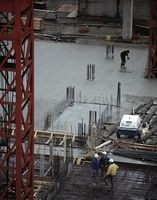A Safety Manual Checklist

All construction sites should hold a safety manual, within which all safety procedures are documented. Any contractors working on site should read and agree to the policies contained within the safety manual before they are allowed to commence work. Construction is a hazardous industry, and so proper safety procedures are vital for avoiding accidents, injuries or fatalities.
Personal Protective Equipment
Personal Protective Equipment, or PPE, is essential for anyone working on site. At the very least, each worker should wear a hard hat, high-visibility jacket or vest and steel toe-capped boots--all of which must be in a good condition. Some specialist workers may require additional items of PPE, such as safety goggles, dust masks or ear defenders. Any PPE should be worn at all times while on site.
Height Protection
Falls from height are a common source of injury and even death on construction sites. Therefore, it's highly important that any raised platforms should have a handrail around the perimeter to prevent a worker from falling. Access to these platforms should be via a ladder or scaffold tower that has been correctly installed and secured. The OSHA (Occupational Safety and Health Administration) states that ladders and other equipment for working at height should not be erected within a 10-feet radius of power lines.
Electrical Safety
Any risk of electrocution should be highlighted by signage.
Any workers carrying out their function in the vicinity of electrical cabling or equipment should be trained in avoiding the hazards that are posed. Electrocution can cause severe injury or even death. Only tools and equipment that have been recently tested to ensure that they are safe should be used, and all cables should be clearly marked to make others aware of the risks.
Equipment Maintenance
All equipment is to be maintained on a regular basis to make sure that it is safe to use. If a tool malfunctions, it can cause serious harm. For example, a circular saw with a blunt disc can easily snag on the material, causing the saw to fly out of the hands of the operator, potentially causing an injury. Routine inspections on all equipment are a must, and any malfunctioning tools should be immediately repaired or replaced.
Personal Protective Equipment
Personal Protective Equipment, or PPE, is essential for anyone working on site. At the very least, each worker should wear a hard hat, high-visibility jacket or vest and steel toe-capped boots--all of which must be in a good condition. Some specialist workers may require additional items of PPE, such as safety goggles, dust masks or ear defenders. Any PPE should be worn at all times while on site.
Height Protection
Falls from height are a common source of injury and even death on construction sites. Therefore, it's highly important that any raised platforms should have a handrail around the perimeter to prevent a worker from falling. Access to these platforms should be via a ladder or scaffold tower that has been correctly installed and secured. The OSHA (Occupational Safety and Health Administration) states that ladders and other equipment for working at height should not be erected within a 10-feet radius of power lines.
Electrical Safety
Any risk of electrocution should be highlighted by signage.
Any workers carrying out their function in the vicinity of electrical cabling or equipment should be trained in avoiding the hazards that are posed. Electrocution can cause severe injury or even death. Only tools and equipment that have been recently tested to ensure that they are safe should be used, and all cables should be clearly marked to make others aware of the risks.
Equipment Maintenance
All equipment is to be maintained on a regular basis to make sure that it is safe to use. If a tool malfunctions, it can cause serious harm. For example, a circular saw with a blunt disc can easily snag on the material, causing the saw to fly out of the hands of the operator, potentially causing an injury. Routine inspections on all equipment are a must, and any malfunctioning tools should be immediately repaired or replaced.
- s2624847fafb253e8690da4636757e2a16.jpg